6 Things To Consider When Implementing A New Content Management Platform
Whether you are a late stage clinical company gearing up for your first commercial launch, or an established commercial entity looking to upgrade your content management platform, there are many pitfalls that can hinder your software from maximizing the quality of your implementation.
While many content management platforms in the marketplace provide an implementation team to help you set up their software, it falls upon you and your team to think through decisions and understand how they may impact your organization over time.
Every organization has its own goals, vision, and values- but these six topics are a good place to start at the beginning of a content management platform implementation:
1. Do you have an SOP, if so, does it need to be updated?
If you work at an established commercial entity there likely is an SOP in place regarding content review and approval; however, a new content management platform could be the perfect time to revisit your procedures and map them to the workflows available in your new software. If you are closer to the beginning of commercialization, now is the time to establish harmonization between your SOP and technology to establish good habits amongst stakeholders that make for an efficient and compliant content review and approval system.
2. Who will be in charge?
Understanding roles for a big software implementation within your company from the beginning will pay off volumes in the long run. Is IT running the show? Marketing Ops? Regulatory? Once you decide on the best layout for your organization, design a RACI chart so everyone on the team understands their role, and who to relay certain issues and questions to as they arise.
3. Is there legacy content?
You could be a late stage company that developed a large volume of disease state awareness and clinical trial recruitment material, a well established commercial entity that is rolling out a new system, or perhaps you just made an acquisition and you need to combine two companies worth of content into one centralized location. Whatever your situation may be, a thoughtful content library migration strategy is going to be essential. If not already in place, this is also a great time to established standard asset naming conventions and metadata standards to help your digital asset librarians.
4. Will all materials be held in the same library? Will Medical and Promotional content be treated differently, what about corporate communications?
This does tie into #3 but is important enough to warrant its own bullet point. Many companies will hold their medical and promotional content in separate libraries, some hold everything in one, and other companies will even leverage their content management platform to aid in the creation and review of corporate communication assets. While companies in our industry are set up in many different ways- the important thing is that you understand how and why you want your content libraries to be setup, and then effectively communicate that to your implementation team.
5. Who is running the review meetings, is it time for a coordinator?
In the early phases of medical and promotional content development, it is not unusual for a marketer or regulatory reviewer to take the lead on running review meetings and taking notes during the discussions. As you move towards a commercial launch, what may have worked in the past becomes less effective. Content volume increases significantly and the need for a designated content coordinator becomes more pronounced. If you can bring an experienced coordinator onto your team from the get-go, your review team will be a step ahead when it comes to compliance and efficiency.
6. How will training occur?
As we’ve mentioned before, recurrent training is a key element in a successful content management process. Though the development of onboarding and continuing education training processes and materials can be daunting, it is important to spend the time and effort to make sure all team members and stakeholders are trained the same way. While the best time to develop this material is during the design and implementation of your software and SOP, it is never too late to get organized and raise the bar moving forward.
Conclusion
Making the decision to implement a new content management platform is a big one, whether you are a small biotech firm or a multi-international company with numerous global brands. Every company’s situation is unique, and therefore, so are the plethora of considerations that need to be made when choosing what platform and processes are right for you. The six topics outlined above will start you down the path of a successful content management platform implementation.
Questions?
Transformation through Collaboration



